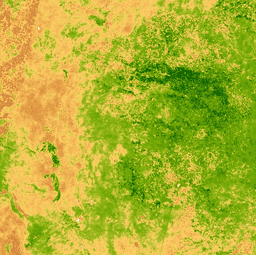AI-generated Key Takeaways
-
This Landsat 5 TM dataset provides 32-day Normalized Difference Vegetation Index (NDVI) composites from 1984 to 2012.
-
The dataset has been superseded by a newer Landsat composite dataset (LANDSAT/COMPOSITES/C02/T1_L2_32DAY_NDVI) and is considered deprecated.
-
NDVI values range from -1.0 to 1.0 and are calculated using the Near-IR and Red bands, representing vegetation health.
-
The composites are created using the top-of-atmosphere (TOA) reflectance, with details described in a research paper by Chander et al.(2009).
-
The dataset is freely available for research, education, and nonprofit use through the Google Earth Engine platform.

- Dataset Availability
- 1984-01-01T00:00:00Z–2012-04-06T00:00:00Z
- Dataset Provider
- Tags
Description
These Landsat 5 TM Collection 1 Tier 1 composites are made from Tier 1 orthorectified scenes, using the computed top-of-atmosphere (TOA) reflectance. See Chander et al. (2009) for details on the TOA computation.
The Normalized Difference Vegetation Index is generated from the Near-IR and Red bands of each scene as (NIR - Red) / (NIR + Red), and ranges in value from -1.0 to 1.0.
These composites are created from all the scenes in each 32-day period beginning from the first day of the year and continuing to the 352nd day of the year. The last composite of the year, beginning on day 353, will overlap the first composite of the following year by 20 days. All the images from each 32-day period are included in the composite, with the most recent pixel as the composite value.
Bands
Bands
| Name | Min | Max | Pixel Size | Description |
|---|---|---|---|---|
NDVI |
-1* | 1* | 30 meters | Normalized Difference Vegetation Index |
Terms of Use
Terms of Use
Landsat datasets are federally created data and therefore reside in the public domain and may be used, transferred, or reproduced without copyright restriction.
Acknowledgement or credit of the USGS as data source should be provided by including a line of text citation such as the example shown below.
(Product, Image, Photograph, or Dataset Name) courtesy of the U.S. Geological Survey
Example: Landsat-7 image courtesy of the U.S. Geological Survey
See the USGS Visual Identity System Guidance for further details on proper citation and acknowledgement of USGS products.